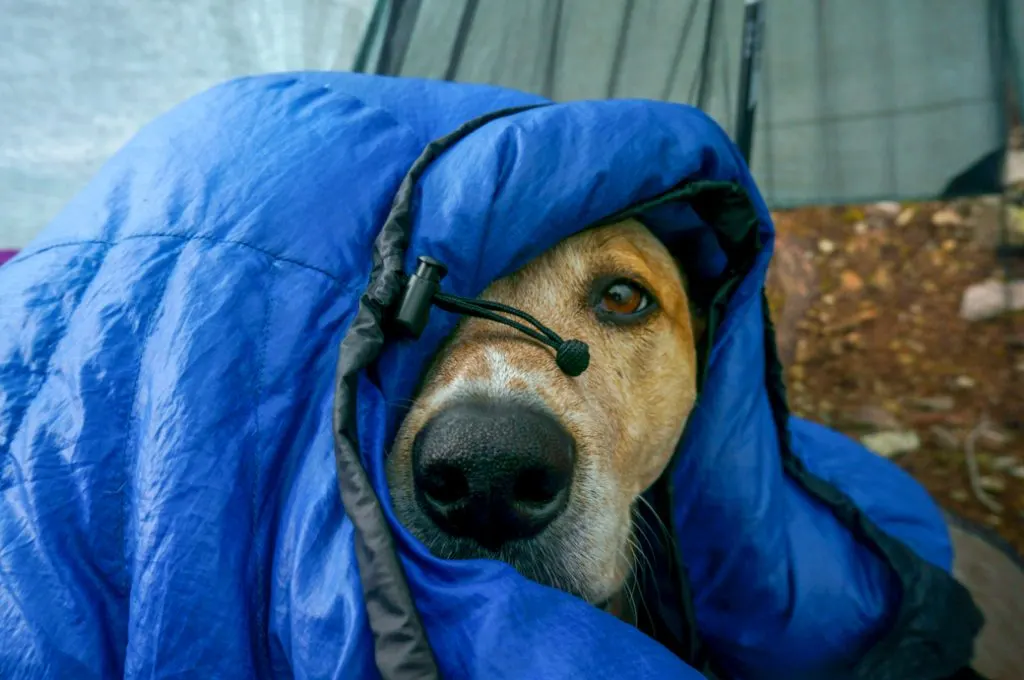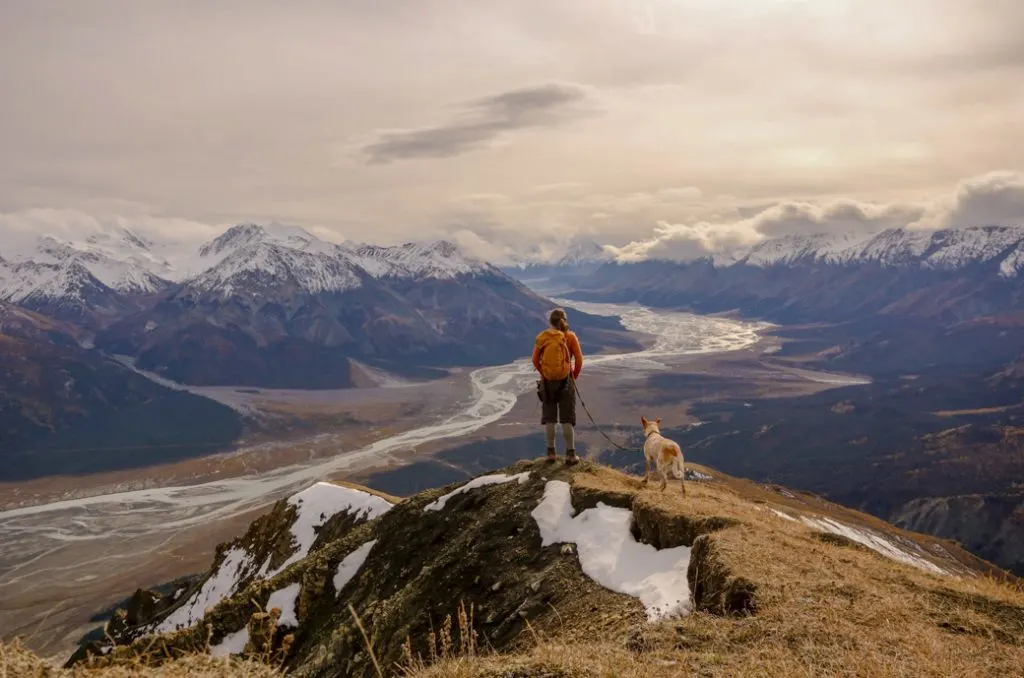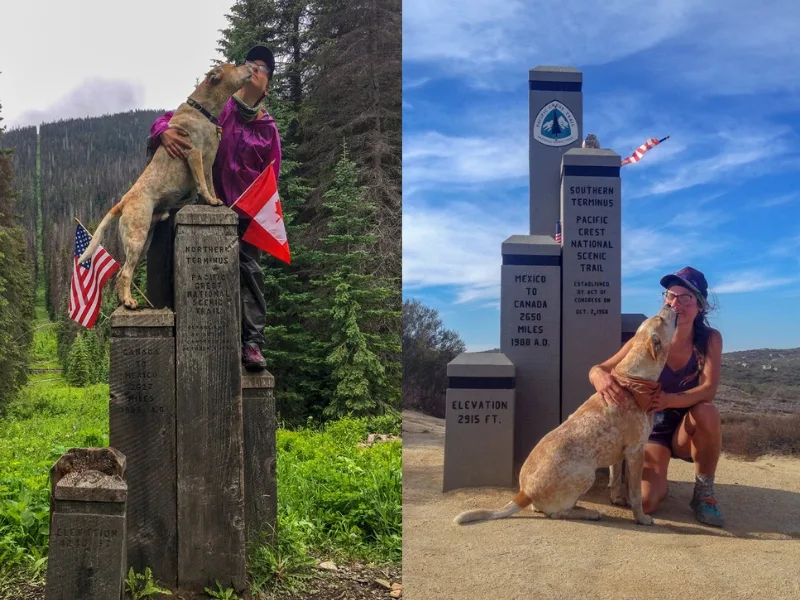As a Leave No Trace trainer, I’m pretty passionate about teaching people the importance of keeping the wilderness wild and minimizing our impact. While I’m pretty well-versed in the theory behind leaving no trace while hiking with a dog, I don’t own a dog. So I didn’t feel qualified to write a post about how to Leave No Trace with dogs.
But you know who is qualified? My friend Amanda. (In fact she’s super-qualified!) She and her dog Frank have hiked and backpacked more miles together than any other human-dog duo I’ve ever heard of. They’ve summited over 50 peaks in BC’s Coast Mountains and last year they thru-hiked the Pacific Crest Trail southbound. (Amanda’s thru-hiker trail name is “Naps”). You can follow along with their adventures on Amanda’s Instagram, @tidelinetoalpine and website, tidelinetoalpine.com. She put together a great overview of the 7 principles of Leave No Trace as they relate to dogs. Plus she added more key guideline to ensure you and your dog have a great trip. Keep reading to learn how to Leave No Trace with dogs. Thanks Amanda! -Taryn
Hey there: Some of the links in this post are affiliate links, which means I earn a small commission at no extra cost to you if you make a purchase. Thanks for your support! -Taryn
With the popularity of outdoor adventures skyrocketing, more and more people are bringing their 4-legged companions with them into wild spaces. Hiking and camping with your dog can make for a great experience. But it can also have a negative impact on those around you and the places you visit.
The more we allow our pets to have a negative impact, the more restrictions we will face as dog owners and the less fun everyone will have on the trails. That includes dog owners and our canine companions. As people who adventure with dogs, it’s important that we are exemplary members of the outdoor community so we can protect wild spaces.
But we also want to make sure that we prevent further restrictions on bringing dogs with us on our hikes. This begins with having a well trained pup and understanding how to apply Leave No Trace with dogs. By being a responsible pet owner and following the Leave No Trace principles, bringing a dog into the wild doesn’t need to have any more impact than humans.
Plan Ahead and Prepare

On any adventure it is important to plan and prepare. But with a dog there are few extra factors to research and consider before heading out. Ignorance is not a excuse for ignoring the rules. Here are some examples of factors to consider when planning and preparing for trip with your dog:
- Check the dog regulations for the area you are headed to (e.g. park, campground, national forest, etc.). Do they allow dogs? What are the leash rules? Often, you are required to use a leash no longer than 6ft. Are there seasonal wildlife closures you need to be aware of? All the relevant information pertaining to is usually online so you can check ahead of time.
- Is your dog prepared for the terrain and trail conditions? Can they handle the distance? Are their paws conditioned for rough surfaces? How does your dog react to wild animals?
- What are the local hazards to your dog such as predators, dangerous terrain or diseases? Is it hunting season where you are going?
- Is your dog prepared for the temperatures you might encounter? Will it be too hot to leave them in a vehicle if you need to? Are they prepared for cold nights at elevation? Can you carry enough water and food for them?
Travel and Camp on Durable Surfaces

A dog walking off-trail does not do as much damage as humans with boots on. But it is still important to keep them on the trail with you. On the trail, dogs will be less likely to get hurt. You can also do a better job keeping them under your control. It’s also easier to ensure you follow other LNT principles such as properly disposing of their waste.
It may not seem like a big deal to allow your dog to run off trail, but they can disturb the nests of ground birds, spread diseases, and trample vegetation or cryptobiotic soils. Digging holes can increase erosion and prevent new plants from establishing themselves. The extent of the potential damage can vary from environment to environment and have negative impacts you may not be aware of.
Choose well established camps with open spaces to allow your dog an area to run where they wont trample vegetation. Camp at least 200ft from water sources because we all know dogs will mark around camp.
Dispose of Waste Properly
It doesn’t matter whether it’s human waste or dog waste – you need to pack it out or bury it. If you bury it, dig a cat-hole at least 6 inches/15cm deep and 200ft/60m from water. In busier places you may be required to pack out all waste. I use a smell-proof container such as a PooVault to help put bagged dog waste in my pack or carry it on the outside without the odour following me all day. If you are burying your dog’s waste make sure your pup is worm-free and not carrying other transmittable diseases or parasites that could negatively effect local wildlife.
Leave What You Find
This Leave No Trace principle applies to your canine too! Your dog may not be removing natural resources or artefacts, but they can transport insects and seeds in their fur. Inspecting them for ticks or other pests is not only in their best interest but can also help prevent spread to other areas. Keeping their coat clean can also help spread seeds of potentially invasive species if you are frequently travelling between different ecosystems such a wilderness, farmland and urban areas.
Minimize Campfire Impacts

This is one LNT principle that doesn’t really apply to dogs, unless you have a unruly dog that likes to drag burning stick out of the fire, in which case you could start a forest fire. I would definitely advise against allowing such behaviour. Plan ahead with the appropriate gear in order to stay warm and avoid building fires as much as possible.
Respect Wildlife
Dogs can dramatically impact an environment by harassing wildlife. Keeping them on a leash or under voice command is important to prevent these types of disturbances. If you are hiking or camping in a place where leashes are not required, it is important that your dog has good recall and won’t wander off. Dogs that take themselves for adventures are more likely to sustain a injury, bother wildlife or bring wildlife (including bears) back to camp.
Be Considerate of Other Visitors

One of the biggest reasons for dogs not being allowed in many places is irresponsible owners who allow their dogs to negatively impact other users. People go out in nature for a variety of reasons, usually including peace and tranquility. Your dog should never be allowed to run up to people and jump on them, treat other dogs poorly, or otherwise cause a disturbance by barking incessantly or begging for food from other hikers. Take extra care to ensure your dog does not spook horses. Some people may be afraid of your dog no matter how nice they are, and others may even have allergies. Even if your dog is allowed off-leash, respect people or other dogs who may not wants your pet in their space.
Hike Your Dog’s Hike (HYDH)

Having reviewed how the 7 principles of Leave No Trace can be applied to your dog, there is one more guideline that I would like to add. I believe it everyone who brings dogs into the outdoors should follow this guideline.
You’ve likely heard the phrase ‘Hike Your Own Hike’, but when you hike with a dog it’s not about you at all. Instead, the best mindset is ‘Hike Your Dog’s Hike’. HYDH means that with every decision you make, take your dog’s needs into account before your own. If you push a dog that beyond its limits, or it is not having its needs met, the dog will be more likely to get injured, cause a disturbance, or make it harder for you to practice Leave No Trace.
It is important for generations of dog people to ensure that we are responsible and thoughtful when hiking and camping with our dogs. That way we can avoid further restrictions to access and freedoms on public lands. As a self-regulating community of outdoor enthusiasts, it’s important for us to speak out if we see people doing irresponsible things or not practicing LNT. Help mentor those new to adventuring with a dog and teach them how to practice LNT. Leave No Trace is not a strict set of rules. Instead we should see it as guidelines that if we ALL follow will allow us to preserve and enjoy nature for generations to come.
Safe trails & happy tails!
-Amanda
READ NEXT:
- How to Leave No Trace (And Why it’s Important!)
- Backpacking Hygiene the Leave No Trace Way
- The 10 Essentials: Things You Should Bring on Every Hike
- 16 Things to do Before a Hike
- How to Leave No Trace With Dogs - April 8, 2019


Maria
Monday 28th of June 2021
I just wanted to drop in and say that this was a incredibly informative post! I will be camping with my corgi for the first time in a few days and I've been doing a bunch of research to help ensure that I have the most enjoyable and stress free experience as possible as well.
As part of my preparations, I actually consolidated a lot of the information that I found online that I thought was super useful into a blog post about camping with dogs for the first time as well. To be honest that post is basically a summary of all the research I've done so I could look back on it myself haha. Anyway, I just wanted to let you know that the tips on this post were so incredibly useful that I hope you don't mind that I linked this post to my own blog post as well - I do want to cite where I found the most useful information after all :)
Thank you again for publishing this incredible post - I really learned so much from this and I can't wait to go 'glamping' with our corgi in a few days using some of the tips and advice this post gave me.